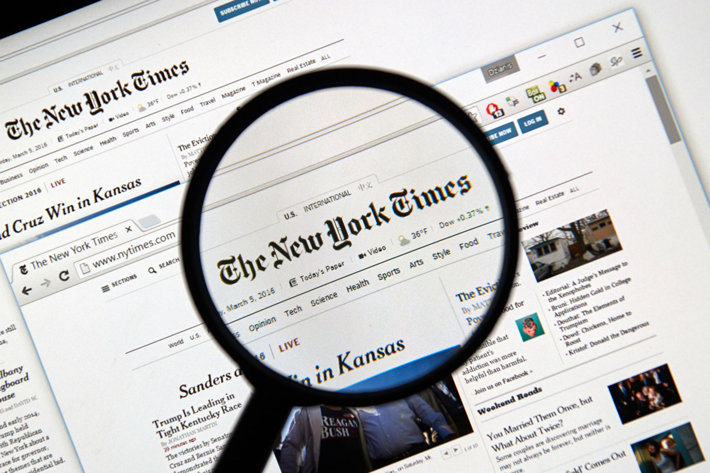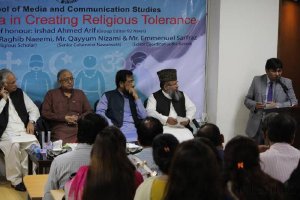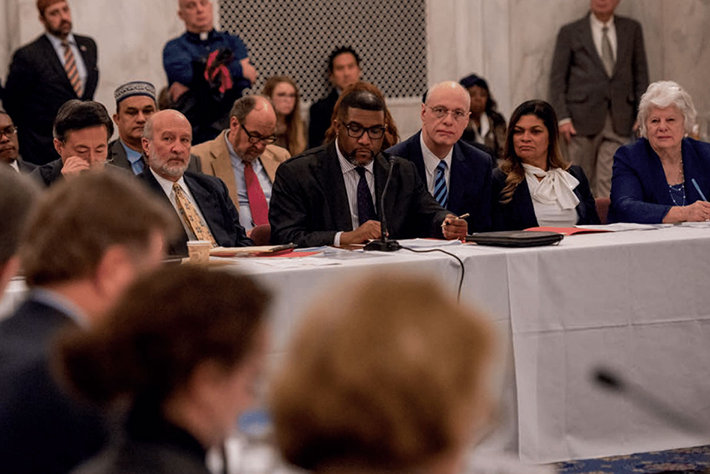
Germany is still having trouble learning the lessons of its shameful past. Religious discrimination remains alive and well, and the New York Times not only forwards it but amazingly refuses to expose it when given every opportunity.
In the most glaring example in recent memory, Okwui Enwezor, former artistic director of the Haus der Kunst museum in Bavaria, attempted to circumvent Germany’s constitution by discriminating against a Scientologist because of his religion. Arnulf von Dall’ Armi was a well-liked employee of the museum for 22 years with an unblemished record when he was abruptly fired out of the blue by Enwezor.
To cover up its employment discrimination, the museum attempted to claim that Mr. von Dall’ Armi was an independent contractor, but nobody bought it. Dall’ Armi sued in labor court and won. The museum appealed and lost, resoundingly. Found liable for wrongful termination, the museum is now facing potentially hundreds of thousands of euros in damages because of its bigotry.
This is just the latest episode showing the German government’s mindset when it comes to religious harassment, on the heels of two decades of far-right discrimination. The euphemistically named Office for the Protection of the Constitution (OPC), purportedly existing to observe unconstitutional activities, has done exactly the opposite: repeatedly attempting to tarnish the impeccable record of the Church of Scientology of helping the people of Germany, by claiming the Scientology religion is “under investigation.” After two decades, nothing has been found, exposing the OPC “investigation” as a sham.
The only noteworthy exposés have been about the OPC itself. Attempting to spy on the Church in Switzerland, in complete violation of the OPC mandate, one of their agents was caught by the Swiss authorities and criminally prosecuted. The German government was sued and ordered to pay damages to Switzerland for OPC’s illegal conduct.
In another bizarre escapade, reminiscent of Nazi conduct in the late 1930s and early 1940s, the Federal Labor Office enacted procedures that would label with an “S” any business owned by a Scientologist (evoking memories of when the Nazis labeled Jews with a “J”).
Nothing illustrates how the OPC is blinded by religious bigotry more than its behavior leading up to the terrorist attacks of 9/11. The agency at the time focused all their agents on the Church of Scientology in Hamburg in a futile effort to find anything. Meanwhile, the terrorists were in the city right under the OPC’s noses, plotting the attacks on the World Trade Center. The terrorists went unnoticed for the fact that all OPC agents, driven by religious frenzy, were occupied with their illegal attempts to discriminate against the Church, missing the most heinous act of terrorism in American history.
The OPC’s misconduct resulted in 47 court cases—either brought by the German government to protect their “right to discriminate” or by Scientologists to overcome that discrimination—all found in favor of the Church and Scientologists. Every case acknowledged the bona fides of the Church and the rights of Scientologists to practice their religion freely.
The escapade with the Haus der Kunst museum comes on the heels of an established body of cases that have all found the Church of Scientology was subjected to repressive, anti-religious actions by the German government. It is amid this background, all public knowledge, that the New York Times decided to report on the latest incident involving the Haus der Kunst museum, buying into Germany’s twisting of the facts in a manner that would make propagandist Goebbels proud.
The Times dubbed it a “Scientology scandal,” when the real scandal was the illegal firing of a Scientologist based on his religion. The newspaper falsely reported that in Bavaria “Scientology is considered a threat to democracy,” a lie and the opposite of what is the case. The paper further reported that “it is illegal for Scientologists to work in government or state-funded organizations,” yet another lie, for the fact that German courts have repeatedly upheld the rights of Scientologists to practice their religion freely and with no prohibition on employment.
The Times also falsely reported that the museum uproar was a “Scientology scandal” because “a group of them (employees) formed a workers’ council to protest” Scientologists being hired on the museum staff, yet another lie. The only protests by the German museum staff were against Enwezor for attempting to smear a long-term and well-respected employee, who happened to be a Scientologist.
The New York Times further failed to report that the museum had lost the discrimination case against them. The Times never reached out to the Church to verify their facts or to seek comment before publishing. When the Church saw the article, all information was immediately provided to the Times, which begrudgingly changed a single line: “it is illegal for Scientologists to work in government or state-funded organizations” to “employees can be dismissed from government or state-funded organizations if they are members of a Scientologist group.” That’s all. The rest of the story stands.
What the Haus der Kunst museum article shows is the hollowness of the Times’ claims to stand up for religious freedom and nondiscrimination. Underneath its sanctimonious “let’s-pat-ourselves-on-the-back” editorials and news coverage opposing religious intolerance in far corners of the world, the Gray Lady for years has all too often refused to defend religious freedom and hold bigots accountable.
The Times has never lived down the notorious article it published in 1922 praising a young Adolf Hitler: “Hitler’s strength is in the combination of his undeniable great gifts as an orator and organizer. He exerts an uncanny control over audiences, possessing remarkable ability to not only rouse his hearers to a fighting pitch of fury, but at will to turn right around and reduce the same audience to docile calmness and good order.”
The Times went on to state: “[S]everal reliable, well-informed sources confirmed the idea that Hitler’s anti-Semitism was not so genuine or violent as it sounded, and that he was merely using anti-Semitic propaganda as a bait to catch masses of followers and keep them aroused, enthusiastic and in line for the time when his organization is perfected and sufficiently powerful to be employed effectively for political purposes.”
Religious discrimination and harassment falls on deaf ears at the Times whose editors prefer to print propaganda and promote blatantly discriminatory, indeed, oppressive actions.
- Take the Times’ coverage of a so-called “investigation” in Belgium where the Church was subjected to 18 years of outrageous oppression—the worst in that country’s history. The entire “investigation” was nothing less than harassment of Scientologists for practicing their religion. Yet the New York Times saw nothing wrong. Driven by a psychotic furor, the trial had all the trappings of a communist-era Star Chamber proceeding. Except all the facts were on the Church’s side and it blew up in the prosecutor’s face. The court resoundingly rejected the case, throwing it out in its entirety as incomprehensible and a blatant attempt to misinterpret the Church’s beliefs and put Scientologists on trial for “the mere fact of being active members of their Church.” The Brussels Court decision set an overriding precedent on behalf of religious freedom in that nation. America would never have tolerated a legal case so oppressive, and neither should the bastion of American journalism. Yet the Times didn’t report on the oppression or the victory, more proof it doesn’t respect the religious rights of others.
- Similarly, one would think that as an American institution, the New York Times would have been outraged in 1988 when in Spain the Guardia Civil, brandishing machine guns, raided a religious assembly at the order of a fascist prosecutor and arrested all foreign Scientologists in attendance, handcuffing 72 in all and parading them in front of local media. The International Church President and others were locked in a Madrid prison notorious for medieval conditions and inhumane treatment of political prisoners during the Franco regime. When the case finally came to trial 14 years later, the Spanish Court unequivocally acquitted all defendants of all charges. The ruling was so decisive that the Spanish government did not appeal. With vindication came full religious recognition, with Scientologists overcoming the military-like crackdown by the fascist government to suppress their right to freely practice their religion. The New York Times devoted but one article to announce the beginning of the trial, but never covered the outcome or the outrageous violation of religious freedoms and human rights.
- In Italy, the Church was fully vindicated in 1997 after a decade-long religious inquisition. The Church investigated and exposed the corruption of the judge and prosecutor who orchestrated the attacks, and disproved each of the false allegations. The Italian Supreme Court issued a decision, determining that Scientology is a bona fide religion, which defines religiosity in Italy. Again, the Times was silent.
- And in the United Kingdom, where the Scientology religion has been practiced for more than six decades and was the home of the religion’s Founder, bigots in the government conspired to marginalize the Church and its rights. The Church challenged an antiquated, discriminatory 1855 Act of Parliament. In December 2013, the UK Supreme Court unanimously ruled not only in favor of Scientology but provided the modern definition of religion for the United Kingdom. The decision was hailed by the British and international press as a landmark ruling, but the New York Times ignored it.
Also going unreported by the Times are the global humanitarian endeavors by the Church or major initiatives such as the March 2018 launch of the Scientology Network, the first television network exclusively dedicated to the Scientology religion—the world’s youngest major religion. This was an event ignored by the Times but covered by USA Today, Variety, the Associated Press, The Hollywood Reporter and many others. The Scientology Network has been praised for shattering the paradigm of religious broadcasting, ushering in a new era that shows a religion in action and making the world better.
Nor has the Times acknowledged the Church’s tremendous growth as evidenced by over 65 new Churches worldwide, including one in its very own neighborhood in Manhattan and another in Harlem. Yet another 78,000-square-foot Scientology Church opened in September in Stuttgart, Germany, similarly unmentioned.
The New York Times is not “all the news that’s fit to print.” If the subject is religious persecution and discrimination, what fits is the propaganda of bias and bigotry.


